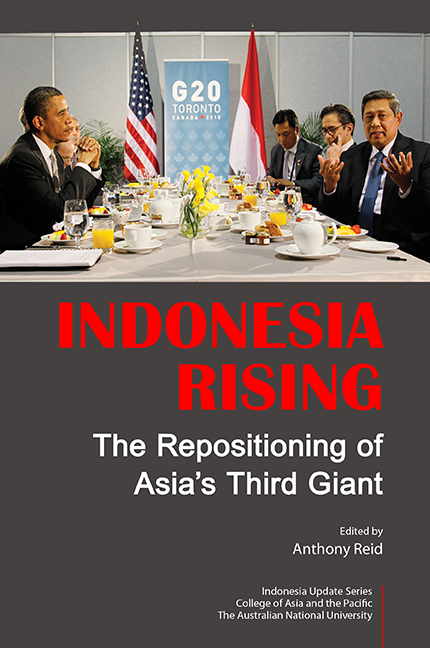Book contents
- Frontmatter
- Contents
- Tables
- Figures
- Contributors
- Foreword by Gareth Evans
- Preface
- Glossary
- 1 Indonesia's New Prominence in the World
- 2 Indonesia in the New World Balance
- 3 Indonesia's Role in the World Economy: Sitting on the Fence
- 4 Is Indonesia Rising? It Depends
- 5 Domestic Politics and International Posture: Constraints and Possibilities
- 6 Can Indonesia Lead on Climate Change?
- 7 Indonesian Muslims and Their Place in the Larger World of Islam
- 8 Indonesia's Quiet Springtime: Knowledge, Policy and Reform
- 9 Problems of Identity and Legitimacy for Indonesia's Place in the World
- Index
- INDONESIA UPDATE SERIES
5 - Domestic Politics and International Posture: Constraints and Possibilities
Published online by Cambridge University Press: 21 October 2015
- Frontmatter
- Contents
- Tables
- Figures
- Contributors
- Foreword by Gareth Evans
- Preface
- Glossary
- 1 Indonesia's New Prominence in the World
- 2 Indonesia in the New World Balance
- 3 Indonesia's Role in the World Economy: Sitting on the Fence
- 4 Is Indonesia Rising? It Depends
- 5 Domestic Politics and International Posture: Constraints and Possibilities
- 6 Can Indonesia Lead on Climate Change?
- 7 Indonesian Muslims and Their Place in the Larger World of Islam
- 8 Indonesia's Quiet Springtime: Knowledge, Policy and Reform
- 9 Problems of Identity and Legitimacy for Indonesia's Place in the World
- Index
- INDONESIA UPDATE SERIES
Summary
There are few countries whose international image has undergone as radical a transformation as Indonesia's within such a short period of time. In the mid-1990s, Indonesia was widely viewed as a major contributor to regional stability in Southeast Asia. Following the political turmoil of 1998–99, however, the country quickly became a source of regional and international concern. Its international image was severely dented by a host of domestic challenges: economic adversity, communal violence, the threat of secession and the growing problem of religious radicalism and terrorism. There were even doubts as to whether Indonesia could survive a democratic transition amidst mounting internal political crises and economic difficulties. By 2004, however, a sense of stability and normalcy had gradually returned, and within a decade of the reintroduction of democracy in 1998, it had become fashionable both within and outside Indonesia to describe the country as a democratic ‘bright spot’ in the developing world.
The changes in Indonesia's international image since Suharto's ascendancy in 1967 – from provider of regional stability to producer of insecurity to consolidating new democracy – have been reflected in differing approaches to foreign policy. As a stable Southeast Asian state for the first three decades, Indonesia was a confident regional player, working to ensure that the maintenance of regional stability would continue to generate prosperity for the region. When domestic order was shattered by dramatic political change in 1998, and national priorities were dictated by the imperative to manage internal political challenges, Indonesia's attention turned inward and it lost its voice in regional, let alone global, affairs. By 2003, however, Indonesia was once again ready to play a more active foreign policy role. It began to take a number of foreign policy initiatives that not only marked the return of a leadership role within the Association of Southeast Asian Nations (ASEAN), but also reflected its desire to invoke a new international image as the world's third-largest democracy and largest moderate Muslim-majority country, and as a ‘bridge builder’ and ‘problem solver’ in the wider global community.
- Type
- Chapter
- Information
- Indonesia RisingThe Repositioning of Asia's Third Giant, pp. 77 - 92Publisher: ISEAS–Yusof Ishak InstitutePrint publication year: 2012



